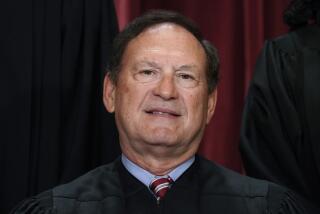Pension Fund Was Sold on KPMG
- Share via
NEW YORK — When two executives of accounting giant KPMG came calling on Los Angeles pension officials in 1999, they pitched what sounded like a cost-free way to fatten the city’s retirement kitty.
Larry Manth and Doug Duncan, then partners in KPMG’s Los Angeles office, were helping to run a nationwide rollout of an innovative tax shelter that promised to shave millions of dollars off the personal tax bills of wealthy private business owners.
The complex plan required the businesses to make temporary charitable donations of corporate stock. But for the shelter to work, KPMG needed to find a tax-exempt institution willing to cooperate by accepting the donations -- and that’s where the Los Angeles Fire and Police Pension System came in.
That KPMG was paying a visit to L.A. pension officials at all was a vivid indication of how, by the late 1990s, the mass-marketing of “tax solutions” had evolved into a powerful sideline for the blue-chip accounting firm. Indeed, it was a faster-growing field than KPMG’s traditional, green-eyeshade business of auditing the books of Fortune 500 corporations.
The shelters were the product of some of the sharpest minds in American tax avoidance, marketed to the wealthy in high-pressure sales blitzes under odd names -- BLIPS, FLIPS, OPIS, SC2 -- that only hinted at their complexity. KPMG told clients that its shelters would save them so much money that the service would be well worth fees of $1 million or more.
Instead, several of the shelters blew up when they were identified as abusive by the Internal Revenue Service, and the IRS began going after KPMG’s tax-shelter clients for interest, back taxes and, sometimes, penalties. Meanwhile, Senate investigators estimated that the shelters cost the federal government $1.4 billion in taxes, minus whatever the IRS is able to recover.
The fallout has left KPMG reeling. In the wake of a Senate probe of tax shelters that was highly critical of KPMG, the firm is facing lawsuits from former tax-shelter clients who are being pursued by the IRS. It also is negotiating with federal prosecutors to resolve a criminal probe and avoid the fate that befell accounting firm Arthur Andersen, which collapsed in 2002 after being convicted of obstruction of justice for its role in the Enron Corp. debacle.
In mid-June, apparently hoping to appease prosecutors, KPMG issued a public apology, saying in part: “KPMG takes full responsibility for the unlawful conduct by former KPMG partners during that period, and we regret that it occurred.”
KPMG’s dealings with the Los Angeles Fire and Police Pension System provide a window into the bewilderingly complex world of tax shelters.
The quasi-municipal agency, known in the trade press by the rakish nickname “L.A. Guns & Hoses,” manages the $12-billion pension fund for city fire fighters and police officers.
Chief Investment Officer Tom Lopez, in a statement submitted to a Senate committee in November 2003, said he took the initial phone call from KPMG’s Manth and Duncan, who said they had clients who were interested in making donations to the fund.
“This was the first time that we had ever heard from them or KPMG,” Lopez said in his statement.
In a subsequent meeting, the KPMG executives laid out a description of the tax shelter known as the S Corporation Charitable Contribution Strategy, or SC2, according to Lopez’ statement. It would eventually become one of KPMG’s top-selling shelters, generating more than $26 million in fees for the firm over two years, according to Senate investigators.
In an S Corporation (named for a subchapter of the U.S. tax code), profits from the business are passed directly to the shareholders, avoiding corporate income tax while retaining other benefits of incorporation. It has been popular with family-owned businesses and other private firms with a handful of shareholders, such as car dealerships and construction companies.
Each year, the shareholders must declare the profits as ordinary personal income, whether the profits are actually distributed to them or are retained by the company for reinvestment in the business or other purposes.
The goal of SC2 was to turn that personal income -- the shareholders’ profits -- into long-term capital gains, which in the late ‘90s were taxed at a much lower rate. The method devised by KPMG was for S Corporation shareholders to issue nonvoting stock, donate it to a tax-exempt entity and buy it back after a couple of years -- time enough to qualify as “long-term” under the tax code.
In a simplified example, suppose an S Corporation has 100 shares. Under the SC2 plan, it issues 900 new, nonvoting shares and donates them to a tax-exempt institution, generating a charitable tax deduction for the corporate shareholders.
While the stock is in its possession, the institution is entitled to 90% of the company’s profits, but in most cases the cash is not distributed but allowed to build up within the company. And because it is tax-exempt, the institution pays no income taxes on its share of the accrued profits.
The original shareholders, meanwhile, must keep paying taxes. But because they now own only 10% of the company -- although all of its voting stock, thereby retaining actual control -- they pay just one-tenth of the income taxes they otherwise would owe.
After two or three years, the tax-exempt entity sells the stock back to the original shareholders. The original shareholders now must pay taxes on all the retained profits, but at the lower, capital-gains rate.
For its part, the tax-exempt entity gets to keep the cash proceeds from the stock sale. The payoff is discounted for various technical reasons, including that its stock carries no voting rights. Still, it’s nothing to sneeze at.
“KPMG estimated that each donation might generate $50,000 to a few hundred thousand dollars for the [L.A. pension] fund,” Lopez said in his Senate statement.
According to Senate investigators, KPMG had identified many wealthy clients who could benefit from SC2, but was having trouble finding a tax-exempt entity willing to cooperate.
On Dec. 16, 1999, the fire and police fund’s board of directors listened to the KPMG pitch and voted to accept the donations, pending clearance from outside tax counsel, according to Lopez’s testimony. The outside lawyers approved the transactions, and almost immediately, donations began pouring into the fund, Lopez testified.
As it turned out, KPMG’s estimate of the pension fund’s potential windfall was conservative. At the time of Lopez’ testimony, the fund had reaped at least $5.9 million from 11 SC2 stock sellbacks plus dividends, with an additional 16 transactions awaiting completion.
In all, according to Senate investigators, the L.A. fund participated in 28 SC2 deals in 2000 and 2001, nearly half of the 58 SC2 transactions that KPMG initiated nationwide before shutting down the program.No one has accused the pension fund of any wrongdoing, although Sen. Carl Levin (D-Mich.), the subcommittee’s ranking minority member, implied that the transactions should have raised eyebrows.
“None of the SC2 tax products could have been sold absent a charity willing to accept S Corporation stock donations under unusual circumstances,” Levin said.
Lopez and his boss, pension system general manager Michael A. Perez, declined to comment.
William H. Jackson III, a real-estate lawyer in Century City and a member of the pension fund’s board of directors, said that Lopez told him he thought the Senate subcommittee’s report “was not accurate and was done for political purposes.”
Manth and Duncan, who have since left KPMG, could not be reached for comment.
Beverly Hills tax lawyer Charles P. Rettig said his firm represented “certain entities who participated in SC2,” but he declined to identify them.
“The SC2 transaction is not the poster child for abusive tax shelters that the government would portray,” Rettig said in an e-mail last week. “The tax result may be highly objectionable to the IRS. But as a technical matter, many knowledgeable practitioners are convinced it will be upheld in litigation.”
Rettig also said it was important to consider the transactions in light of the time they were made. In the late 1990s, before Enron’s collapse, the major accounting firms had international brand names and were known to hire the best and the brightest in accounting and tax law. At that time, it would not have been unusual for even a seasoned tax lawyer to defer to a KPMG or Ernst & Young if the firm was willing to put its name behind a tax transaction.
In their 2003 probe, Senate investigators spotlighted four KPMG tax shelters that the IRS listed as abusive. Investigators said KPMG tax partners were pressured to generate ideas for shelters that could be mass-marketed to wealthy Americans.They found that KPMG used confidential data from its audit clients to help identify potential tax-shelter customers and that it took steps to conceal its activity from the IRS.
Rival accounting firms Ernst & Young and PricewaterhouseCoopers also came in for criticism from lawmakers, as did outside banks, law firms and consultants that helped to structure and sell the shelters.
The Justice Department’s parallel criminal investigation -- targeting KPMG, some of its former partners, and other financial and professional firms and individuals -- appears to be gathering momentum.
On Aug. 11, former bank accountant Domenick DeGiorgio pleaded guilty to fraud and other felonies arising from his work on KPMG tax shelters as a then-managing partner in the New York branch of German-owned bank HVB Group.
It was the first prosecution in the criminal investigation. Legal experts said the likelihood that DeGiorgio would become a cooperating witness for the prosecution increases the pressure on other targeted professionals to cut deals with the government and on KPMG to settle its case.
Although some KPMG ex-partners are expected to be indicted, legal experts believe that the government, chastened by the Arthur Andersen case, will stop short of bringing criminal charges against the firm itself.
When the Supreme Court this year overturned Andersen’s conviction, it was cold comfort: It already had gone out of business with a loss of 28,000 U.S. jobs.
The Department of Justice doesn’t want to be responsible for cutting the Big Four (once the Big Five) down to a Big Three, with further loss of jobs and a reduction in competition in the corporate accounting field, experts said. However, prosecutors are expected to push for fines of $500 million or more plus tightened strictures governing the firm’s behavior.
On Friday, meanwhile, published reports said Mississippi may file criminal charges against KPMG in connection with tax strategies the firm devised for what was then known as WorldCom Inc., the Clinton, Miss.-based telecom giant that collapsed in 2002 amid the largest accounting fraud in the U.S.
As early as 2003, KPMG began dismantling its tax-shelter development and marketing operations and cutting ties with outside firms involved in the business. In its June 16 apology, the firm said it had “put in place a process to ensure that those responsible for wrongdoing have been separated from the firm.”
KPMG said it also had adopted “structural, cultural and governance reforms to ensure the highest ethical standards.”
More to Read
Inside the business of entertainment
The Wide Shot brings you news, analysis and insights on everything from streaming wars to production — and what it all means for the future.
You may occasionally receive promotional content from the Los Angeles Times.










